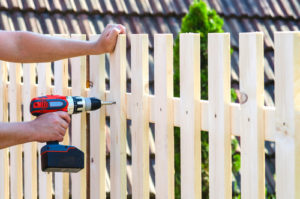 “Good fences make good neighbors,” the saying goes.
“Good fences make good neighbors,” the saying goes.
The opposite is also true. As with any other type of construction, fence installation requires a certain amount of planning and consideration in order to minimize impact to the neighborhood. Here are a few things you should think about before you start building a new fence, which will help ensure that both you and your neighbors are happy with the result.
Apply for Your Fence Permit
Most municipalities, townships and counties require a permit for fence installation. Specific regulations and codes vary widely, so be sure you are clear on the requirements in your area before planning a fence.
Measure Your Property
Next, you’ll need to figure out exactly where your fence will sit. Normally, your fence installer will do the measuring. However, if your fence is on or near your property line (as most are), it’s very important for you to know exactly where your property lines are. If you don’t know, you will probably need to get your property surveyed. Also, if your fence will abut a neighbor’s property, you may need to get their permission before installing it.
Choose the Right Fence for Your Needs
A good fence is an investment. People often let price dictate their choice of fencing. However, keep in mind that a low price doesn’t always mean good value.
When you shop for a new fence, consider its purpose as well as your lifestyle needs. Do you need to contain pets and kids? Is privacy your aim? Or perhaps you need something for noise reduction? How important are aesthetics in this location? And how much maintenance do you want to commit to?
There are hundreds of different types of fencing available. Your answers to these questions will help narrow your choices and avoid being overwhelmed. Keep in mind that each type of fencing material has its pros and cons. Don’t be afraid to enlist the help of your fencing professional in choosing the best type of fencing for your needs.
Flag Your Utility Lines
Because fence installation involves digging, it’s very important that all underground utility lines be clearly marked before work begins. Normally your fencing company will contact the utility companies in advance. Utility workers will come out and mark your utility lines. (If your fence company doesn’t provide this service, you can do it yourself by calling 811 from anywhere in the United States, or by making an online request on call811.com two to three days before work begins).
Be aware that the utility companies will mark only their lines. If you have an underground sprinkler system, dog fence or gas line to a grill or outdoor fireplace, it’s your responsibility to mark these lines. It’s a good idea, too, to walk the property with your fencing installers and point out the lines before they go to work.
Trim Your Fence Line
Your fencing crew will need clear access to all portions of your fence line. That means clearing any brush or debris and/or removing trees in the way. It’s also helpful to mow any turf areas in advance of fence installation. If you are unable to do this yourself, be sure to inform your fencing contractor so it can include this work as part of the bid.
Prepare for Dirt Removal
Fence posts must be set fairly deep if you want a sturdy fence that lasts. This means you’ll end up with quite a lot of displaced dirt on your property. Consider how you want to handle this. Most fencing contractors will offer haul-away services. Otherwise, be prepared to show your installers where on your property you would like them to put the fill, and/or haul it away yourself.
Taking care of these few details will help ensure that your fence installation goes smoothly and without incident. Not only will you be happier with the result, but your neighbors are sure to appreciate it, too!
Chris Buenz is the owner of First Fence Company in Chicago, IL. With over 18 years of experience in both fencing and sales, Buenz is well versed in the Chicago area business market.

